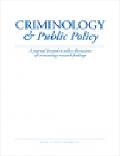
Criminologists and politicians walk to the beat of different drummers. The 4-year rhythm of political terms and the 24-hour buzz of the postmodern news cycle disrupt the slow and steady cadence of academic research. Criminologists strive for analytic rigor, sound research design, and objectivity, especially when trying to understand causal effects such as those demanded in most evaluation research. Politicians, however, pledge their allegiance not to the scientific method but to their constituents. Problems need fixing, lives need saving, and most nonacademics need solutions at a pace quicker than the processes of peer review. As a result, whereas the criminologist waits to make claims about causality and program efficacy until field experiments and mathematical models are complete, politicians and other denizens of the “real world” often rely on back-of-the-envelope calculations or simple cross-tabulations made on spreadsheets to discern whether a violence prevention program “works.” Linking specific programs to decreases in crime becomes more of an art than a science.
Such divergent worldviews between science and politics have profound implications on violence prevention efforts. “Successful” violence prevention programs typically can secure better funding and resources, not to mention the attention of community leaders, politicians, and the press. Yet who determines whether a violence prevention effort is a success? The academic with his or her regression tables and field experiments? Program administrators and front-line workers with their on-the-ground knowledge and experience? Or the politicians addressing the problems of constituents? And what impact does a programmatic “failure” have on subsequent prevention efforts?